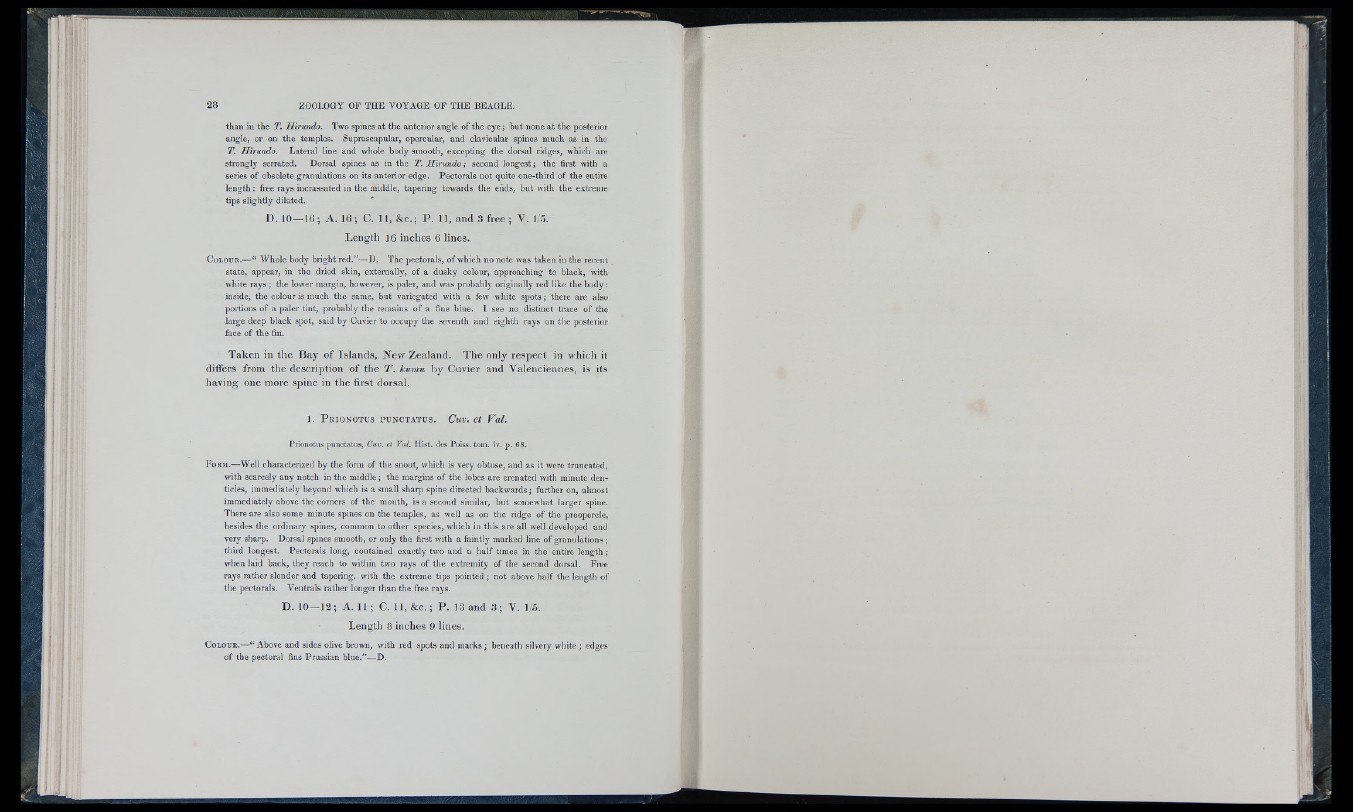
than in the T . H irundo. Two spines at the anterior angle of the eye; but none at the posterior
angle, or on the temples. Suprascapular, opercular, and clavicular spines much as in the
T. H irundo. Lateral line and whole body smooth, excepting the dorsal ridges, which are
strongly serrated. Dorsal spines as in the T. H irundo; second longest; the first with a
series o f obsolete granulations on its anterior edge. Pectorals not quite one-third of the entire
length : free rays incrassated in the middle, tapering towards the ends, but with the extreme
tips slightly dilated. '
D. 10— 16; A. 16 ; C. 11, &c.; P . 11, and 3 free ; V. 1/5.
Length 16 inches 6 lines.
C o l o u r .—“ W hole body bright red.”— D . The pectorals, of which no note was taken in the recent
state, appear, in the dried skin, externally, of a dusky colour, approaching to black, with
white rays ; the lower margin, however, is paler, and was probably originally red like the body :
inside, the colour is much the same, but variegated with a few white spots; there are also
portions of a paler tint, probably the remains of a fine blue. 1 see no distinct trace of the
large deep black spot, said by Cuvier to occupy the seventh and eighth rays on the posterior
face of the fin.
Taken in the Bay of Islands, New Zealand. The only respect in which it
differs from the description of the k u m u by Cuvier and Valenciennes, is its
having one more spine in the first dorsal.
1. P r i o n o t u s p u n c t a t u s . C u v . e t V a l.
Prionotus punctatus, Cuv. et Val. Hist, des Poiss. tom. iv. p. 68.
F orm.—W ell characterized by the form of the snout, which is very obtuse, and as it were truncated,
with scarcely any notch in the m iddle; the margins of the lobes are crenated with minute denticles,
immediately beyond which is a small sharp spine directed backw ards; further on, almost
immediately above the corners of the m outh, is a second similar, but somewhat larger spine.
There are also some m inute spines on the temples, as well as on the ridge o f the preopercle,
besides the ordinary spines, common to other species, which in this are all well developed and
very sharp. Dorsal spines smooth, or only the first with a faintly marked line of granulations ;
third longest. Pectorals long, contained exactly two and a h alf times in the entire length ;
when laid back, they reach to within two rays of the extremity of the second dorsal. Free
rays rather slender and tapering, with the extreme tips p ointed; not above half the length of
the pectorals. Ventrals rather longer than the free rays.
D. 10—12; A. 11 ; C. 11, & c.; P. 13 and 3 ; V. 1/5.
Length 8 inches 9 lines.
C olour.— “ Above and sides olive brown, with red spots and m arks ; beneath silvery white ; edges
of the pectoral fins Prussian blue.”— D.